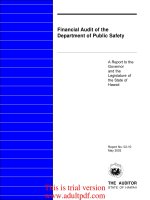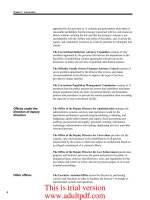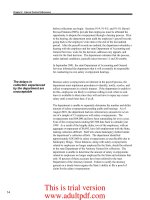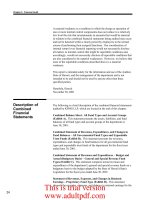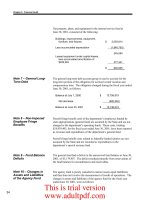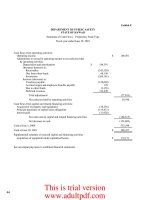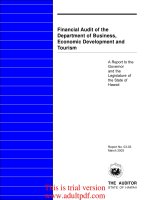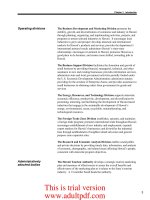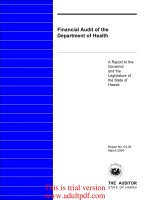Financial Audit of the Department of Hawaiian Home Lands A Report to the Governor and the Legislature of the State of Hawaii Report No. 02-13 September 2002_part4 doc
Bạn đang xem bản rút gọn của tài liệu. Xem và tải ngay bản đầy đủ của tài liệu tại đây (198.36 KB, 10 trang )
23
Chapter 3: Financial Audit
Chapter 3
Financial Audit
This chapter presents the results of the financial audit of the Department
of Hawaiian Home Lands, State of Hawaii, as of and for the fiscal year
ended June 30, 2001. This chapter includes the independent auditors’
report and the report on compliance and on internal control over
financial reporting based on an audit of financial statements performed in
accordance with Government Auditing Standards as they relate to the
department. It also displays the combined financial statements of all
fund types and account groups administered by the department together
with explanatory notes and supplementary information.
In the opinion of Grant Thornton LLP, based on their audit, except for
the effects of such adjustments, if any, as might have been determined to
be necessary had they been able to obtain sufficient evidential matter
supporting the amount of the allowance for loan losses as discussed in
the third paragraph of their independent auditors’ report and except for
the effects of excluding ancillary costs for fixed assets as discussed in
the fourth paragraph and not correcting for errors in prior year’s financial
statements for amounts related to infrastructure improvements
expenditures and liabilities and home construction costs incurred in the
year ended June 30, 2000, as discussed in the fifth and sixth paragraphs,
respectively, of their independent auditors’ report, the combined
financial statements present fairly, in all material respects, the financial
position of the department as of June 30, 2001, and the results of its
operations for the year then ended in conformity with accounting
principles generally accepted in the United States of America. Grant
Thornton LLP noted certain matters involving the department’s internal
control over financial reporting and its operations that the firm
considered to be reportable conditions, including material weaknesses as
defined in the report on compliance and on internal control over financial
reporting based on an audit of financial statements performed in
accordance with Government Auditing Standards. Grant Thornton LLP
also noted that the results of its tests disclosed no instances of
noncompliance that are required to be reported under Government
Auditing Standards.
Summary of
Findings
This is trial version
www.adultpdf.com
24
Chapter 3: Financial Audit
The Auditor
State of Hawaii:
We have audited the accompanying combined financial
statements of the Department of Hawaiian Home Lands, State of
Hawaii, as of and for the year ended June 30, 2001. These
combined financial statements are the responsibility of the
department’s management. Our responsibility is to express an
opinion on these combined financial statements based on our
audit.
Except as discussed in the following paragraph, we conducted
our audit in accordance with auditing standards generally
accepted in the United States of America and the standards
applicable to financial audits contained in Government Auditing
Standards, issued by the Comptroller General of the United
States. Those standards require that we plan and perform the
audit to obtain reasonable assurance about whether the combined
financial statements are free of material misstatement. An audit
includes examining, on a test basis, evidence supporting the
amounts and disclosures in the combined financial statements.
An audit also includes assessing the accounting principles used
and significant estimates made by management, as well as
evaluating the overall financial statement presentation. We
believe that our audit provides a reasonable basis for our
opinion.
The department has loans receivable of $43,495,320, net of an
allowance for losses of $3,732,000 as of June 30, 2001. The
department was unable to provide sufficient evidential matter
supporting the amount of the allowance for loan losses. It is not
possible to form an opinion about the allowance for losses on
loans receivable.
The department has not included in fixed assets ancillary costs
necessary to place the assets into their intended condition for
use. In our opinion, fixed assets should include ancillary costs
necessary to place the assets into their intended condition for use
in order to conform with accounting principles generally
accepted in the United States of America. The effects of that
departure on the combined financial statements have not been
determined.
The department recorded expenditures in the amount of
$1,816,100 for infrastructure improvements to land in the year
ended June 30, 2001 that related to a fund liability incurred in
Independent
Auditors’ Report
This is trial version
www.adultpdf.com
25
Chapter 3: Financial Audit
the year ended June 30, 2000. In our opinion, these expenditures
and liability should have been recognized in the year ended
June 30, 2000 and the beginning fund balance as of July 1, 2000
should have been decreased by $1,816,100 and the expenditures
for the year ended June 30, 2001 should have been decreased by
$1,816,100 to conform to accounting principles generally
accepted in the United States of America.
The department recorded expenditures in the amount of
$647,267 in the year ended June 30, 2000 for home construction
costs. In our opinion, the costs should have been capitalized as
inventory of homes for sale in the year ended June 30, 2000 and
the beginning fund balance as of July 1, 2000 and home
construction/capital projects expenditures for the year ended
June 30, 2001 should be increased by $647,267 to conform with
accounting principles generally accepted in the United States of
America.
As discussed in note A to the combined financial statements, the
combined financial statements of the department are intended to
present the financial position and results of operations of only
that portion of the funds and account groups of the State of
Hawaii that are attributable to the transactions of the department.
In our opinion, except for the effects of such adjustments, if any,
as might have been determined to be necessary had we been able
to obtain sufficient evidential matter supporting the amount of
the allowance for loan losses as discussed in the third paragraph,
and except for the effects of excluding ancillary costs for fixed
assets as discussed in the fourth paragraph, and not correcting
for errors in prior year’s financial statements for amounts related
to infrastructure improvements expenditures and liabilities and
home construction costs incurred in the year ended June 30,
2000 as discussed in the fifth and sixth paragraphs, respectively,
the combined financial statements referred to above present
fairly, in all material respects, the financial position of the
Department of Hawaiian Home Lands, State of Hawaii, as of
June 30, 2001, and the results of its operations for the year then
ended in conformity with accounting principles generally
accepted in the United States of America.
In accordance with Government Auditing Standards, we have
also issued our report dated February 4, 2002 on our
consideration of the department’s internal control over financial
reporting and on our tests of its compliance with certain
provisions of laws, regulations, contracts, and grants. That
report is an integral part of an audit performed in accordance
This is trial version
www.adultpdf.com
26
Chapter 3: Financial Audit
with Government Auditing Standards and should be read in
conjunction with this report in considering the results of our
audit.
Our audit was performed for the purpose of forming an opinion
on the combined financial statements taken as a whole of the
department as of and for the year ended June 30, 2001. The
supplementary information included in Schedules I and II is
presented for purposes of additional analysis and is not a
required part of the combined financial statements. Such
information has been subjected to the auditing procedures
applied in our audit of the combined financial statements and, in
our opinion, except for the effects of such adjustments, if any, as
might have been determined to be necessary had we been able to
obtain sufficient evidential matter supporting the amount of the
allowance for loan losses as discussed in the third paragraph, and
except for the effects of excluding ancillary costs for fixed assets
as discussed in the fourth paragraph, and not correcting for
errors in the prior year’s financial statements for amounts related
to infrastructure improvements expenditures and liabilities and
home construction costs incurred in the year ended June 30,
2000 as discussed in the fifth and sixth paragraphs, respectively,
is fairly stated in all material respects in relation to the combined
financial statements taken as a whole.
/ s / Grant Thornton LLP
Honolulu, Hawaii
February 4, 2002
The Auditor
State of Hawaii:
We have audited the combined financial statements of the
Department of Hawaiian Home Lands, State of Hawaii, except
for the allowance for loan losses, as of and for the fiscal year
ended June 30, 2001, and have issued our report thereon dated
February 4, 2002. We conducted our audit in accordance with
auditing standards generally accepted in the United States of
America and the standards applicable to financial audits
contained in Government Auditing Standards, issued by the
Comptroller General of the United States.
Report on
Compliance and
on Internal Control
Over Financial
Reporting Based
on an Audit of
Financial
Statements
Performed in
Accordance with
Government
Auditing
Standards
This is trial version
www.adultpdf.com
27
Chapter 3: Financial Audit
Compliance
As part of obtaining reasonable assurance about whether the
department’s combined financial statements are free of material
misstatement, we performed tests of its compliance with certain
provisions of laws, regulations, contracts, and grants, including
applicable provisions of the Hawaii Public Procurement Code
(Chapter 103D, Hawaii Revised Statutes) and procurement rules,
directives, and circulars, noncompliance with which could have
a direct and material effect on the determination of combined
financial statement amounts. However, providing an opinion on
compliance with those provisions was not an objective of our
audit and, accordingly, we do not express such an opinion. The
results of our tests disclosed no instances of noncompliance that
are required to be reported under Government Auditing
Standards.
Internal control over financial reporting
In planning and performing our audit, we considered the
department’s internal control over financial reporting in order to
determine our auditing procedures for the purpose of expressing
our opinion on the combined financial statements and not to
provide assurance on the internal control over financial
reporting. However, we noted certain matters involving the
internal control over financial reporting and its operation that we
consider to be reportable conditions. Reportable conditions
involve matters coming to our attention relating to significant
deficiencies in the design or operation of the internal control
over financial reporting that, in our judgment, could adversely
affect the department’s ability to record, process, summarize,
and report financial data consistent with the assertions of
management in the combined financial statements. Reportable
conditions are described in Chapter 2 of this report.
A material weakness is a condition in which the design or
operation of one or more of the internal control components does
not reduce to a relatively low level the risk that misstatements in
amounts that would be material in relation to the combined
financial statements being audited may occur and not be detected
within a timely period by employees in the normal course of
performing their assigned functions. Our consideration of the
internal control over financial reporting would not necessarily
disclose all matters in the internal control that might be
reportable conditions and, accordingly, would not necessarily
disclose all reportable conditions that are also considered to be
material weaknesses. However, of the reportable conditions
described, we consider the items related to the documentation for
This is trial version
www.adultpdf.com
28
Chapter 3: Financial Audit
the methodology for determining the allowance for doubtful
accounts for loans receivables and the recording of infrastructure
improvements expenditures and liabilities in the proper period to
be material weaknesses as described in Chapter 2 of this report.
This report is intended solely for the information of the Auditor,
State of Hawaii, and the management of the department and is
not intended to be and should not be used by anyone other than
these specified parties.
/ s / Grant Thornton LLP
Honolulu, Hawaii
February 4, 2002
The following is a brief description of the combined financial statements
and supplementary information audited by Grant Thornton LLP, which
are located at the end of this chapter.
Combined Balance Sheet – All Fund Types and Account Groups
(Exhibit 3.1). This statement presents the assets, liabilities, and fund
equity of all fund types and account groups of the department at June 30,
2001.
Combined Statement of Revenues, Expenditures, and Changes in
Fund Balances – All Governmental Fund Types and Expendable
Trust Funds (Exhibit 3.2). This statement presents the revenues,
expenditures, and changes in fund balances for all governmental fund
types and expendable trust funds of the department for the fiscal year
ended June 30, 2001.
Combined Statement of Revenues and Expenditures – Budget and
Actual – General and Special Revenue Fund Types (Exhibit 3.3).
This statement compares actual revenues and expenditures of the
department’s general and special revenue funds on a budgetary basis to
the budget adopted by the State of Hawaii (State) Legislature for the
fiscal year ended June 30, 2001.
Description of
Combined
Financial
Statements and
Supplementary
Information
Combined financial
statements
This is trial version
www.adultpdf.com
29
Chapter 3: Financial Audit
Combining Schedule of Balance Sheet Information – Special
Revenue Funds (Schedule I). This schedule presents the assets,
liabilities, and fund equity of the special revenue funds of the department
at June 30, 2001.
Combining Schedule of Revenues, Expenditures, and Changes in
Fund Balances – Special Revenue Funds (Schedule II). This schedule
presents the revenues, expenditures, and changes in fund balances of the
special revenue funds of the department for the fiscal year ended
June 30, 2001.
Explanatory notes which are pertinent to an understanding of the
combined financial statements and financial condition of the Department
of Hawaiian Home Lands, State of Hawaii, are discussed in this section.
The Department of Hawaiian Home Lands is headed by the Hawaiian
Homes Commission. The department was established by Section 24,
Act 1 (the Hawaii State Government Reorganization Act of 1959),
Second Special Session Laws of Hawaii 1959, and is responsible for the
administration of the Hawaiian Homes Commission Act of 1920 enacted
by the United States Congress. The Hawaiian Homes Commission Act
of 1920 sets aside certain public lands as Hawaiian home lands to be
utilized in the rehabilitation of native Hawaiians.
The following is a summary of significant accounting policies:
1.
Reporting Entity – The department is part of the executive branch of
the State. The department’s combined financial statements are
intended to present the financial position and results of operations of
only that portion of the funds and account groups of the State that are
attributable to the transactions of the department. The state
comptroller maintains the central accounts for all State funds and
publishes financial statements for the State annually, which includes
the department’s financial activities.
2. Fund Accounting – The accounts of the department are organized on
the basis of funds and account groups, each of which is considered a
separate accounting entity. The financial activities of each fund are
accounted for with a separate set of self-balancing accounts which
represent the funds’ assets, liabilities, fund equity, revenues, and
expenditures. Account groups are used to establish accounting
control and accountability for the department’s general fixed assets
and general long-term obligations. Account groups are not funds as
they do not reflect available resources.
Notes to
Combined
Financial
Statements
Note A – Significant
Accounting Policies
Supplementary
information
This is trial version
www.adultpdf.com
30
Chapter 3: Financial Audit
Governmental Fund Types
General Fund – The general fund is used to account for all financial
activities except those required to be accounted for in another fund.
The annual operating budget, as authorized by the State Legislature,
provides the basic framework within which the resources and
obligations of the general fund are accounted.
Special Revenue Funds – Special revenue funds are used to account
for the proceeds of specific revenue sources (other than expendable
trusts) that are restricted to expenditures for specified purposes.
Revenues are primarily from general leases, licenses, and permits
granted for commercial, residential, agricultural, and pastoral uses;
and interest and investment income.
Capital Projects Fund – The capital projects fund is used to account
for financial resources to be used for the acquisition or construction
of major capital facilities.
Debt Service Fund – The debt service fund accounts for the
accumulation of resources for and payment of general long-term debt
principal and interest. The principal sources of funds are transfers of
funds from revenues from available lands and interest earned on
investments in the debt service fund and from revenue bond
proceeds.
Fiduciary Fund Types
Expendable Trust Fund – The expendable trust fund accounts for
funds from the State to be expended by the department as provided
by law upon approval by the Hawaiian Homes Commission and used
for capital improvements and other purposes undertaken in
furtherance of the Hawaiian Homes Commission Act of 1920.
Agency Fund – The agency fund accounts for security deposits held
for the department’s lessees as security for leased properties.
Account Groups
General Fixed Assets Account Group – General fixed assets acquired
for use by the department in the conduct of its general governmental
operations are accounted for in the general fixed assets account
group at cost or estimated fair market value at date of donation.
Accumulated depreciation is not recorded in the general fixed assets
account group.
This is trial version
www.adultpdf.com
31
Chapter 3: Financial Audit
General Long-Term Debt Account Group – Revenue bonds,
unmatured long-term general obligation bonds, and the obligation for
the long-term portion of accrued vested vacation is recorded in the
general long-term debt account group.
3. Basis of Accounting – All governmental funds and the expendable
trust funds are accounted for using the modified accrual basis of
accounting. Under the modified accrual basis of accounting,
revenues are recognized when they become measurable and
available. Expenditures are generally recognized when the related
fund liability is incurred. An exception to this general rule includes
accumulated unpaid vacation which is not payable from expendable
available resources and is therefore included in the general long-term
debt account group.
4.
Appropriations – An authorization granted by the State Legislature
permitting a state agency, within established fiscal and budgetary
controls, to incur obligations and to make expenditures.
Appropriations are allotted quarterly. The allotted appropriations
lapse if not expended by or encumbered at the end of the fiscal year,
except for allotted appropriations related to capital projects.
5. Encumbrances – Encumbrance accounting, under which purchase
orders, contracts, and other commitments for the expenditure of
moneys are recorded in order to reserve that portion of the applicable
appropriation, is employed as an extension of formal budgetary
integration in the governmental fund types. Encumbrances
outstanding at fiscal year-end are reported as reservations of fund
balances since they do not constitute expenditures or liabilities.
6. Cash and Short-term Investments – Cash reported in the combined
balance sheet includes cash in the State Treasury, cash in various
Hawaii banks, bank repurchase agreements, and time certificates of
deposit.
The State maintains a cash pool that is available for all funds. Each
fund type’s portion of this pool is displayed on the combined balance
sheet within cash and short-term investments. Those funds are
pooled with funds from other state agencies and departments and
deposited in approved financial institutions by the state director of
finance. Deposits not covered by federal deposit insurance are fully
collateralized by government securities held in the name of the State
by third party custodians. Interest income from this cash pool is
allocated to the various departments and agencies based upon their
average cash balance for the period.
The Hawaii Revised Statutes (HRS) authorize the director of finance
to invest in obligations of or guaranteed by the U.S. Government,
This is trial version
www.adultpdf.com
32
Chapter 3: Financial Audit
obligations of the State, federally-insured savings and checking
accounts, time certificates of deposit, and repurchase agreements
with federally-insured financial institutions.
7. Accumulated Vacation and Sick Leave – Eligible employees are
credited with vacation at a rate of 168 hours per calendar year.
Accumulation of such vacation credits is limited to 720 hours at
calendar year end. Liabilities for vacation pay are inventoried at the
end of each accounting period and adjusted to current salary levels.
The liability is included in the general long-term debt account group
since substantially all of the liability is not expected to be liquidated
using expendable available financial resources.
Eligible employees are credited with sick leave at a rate of one and
three-quarter days per month of service. Unused sick leave may be
accumulated without limit but can be taken only in the event of
illness or other incapacitation and is not convertible to pay upon
termination of employment. Accordingly, accumulated sick leave is
not included in the department’s combined balance sheet. However,
an employee who retires or leaves government service in good
standing with 60 days or more in unused sick leave is entitled to
additional service credit in the Employees’ Retirement System, State
of Hawaii. Accumulated sick leave as of June 30, 2001 was
approximately $2,952,000.
8.
Intrafund and Interfund Transactions – Significant transfers of
financial resources between activities and appropriations included
within the same fund are eliminated. Transfers of revenues from
funds authorized to receive them to funds authorized to expend them
have been recorded as operating transfers in the combined financial
statements.
9. Inventory – Inventory of materials and supplies is recorded as
expenditures when purchased.
10. Inventory of Homes for Sale – The direct costs of homes constructed
by the department are capitalized for the purpose of accumulating
costs to match with sales revenues. Infrastructure costs, which
includes the grading of land, roads, sidewalks, utility lines, and
sewers, are not capitalized. Interest, real estate taxes, insurance, and
overhead costs are also expensed when incurred by the department.
The sales of homes are recorded, and profit or loss is recognized in
full, at the time of closing. The apportionment of total cost and total
profit is in the same ratio as to the sales price.
This is trial version
www.adultpdf.com
